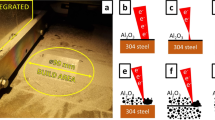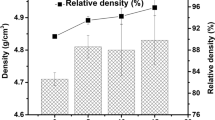Abstract
Present technologies allow fabrication of aluminum/diamond particles composites with excellent thermal properties, in particular showing the by far highest Thermal Conductivity of any of the materials being evaluated for thermal management. Although there is a widespread consensus concerning the essential role that the interface plays, it is not yet fully clear how the aluminum carbide formed at the interface affects thermal properties. In particular, how it affects the stability of the thermal properties of composites subjected to thermal treatments under wetting conditions. This is precisely the objective of the present work. To this end, samples were fabricated by means of gas pressure infiltration of liquid Al into preforms of packed diamond particles. Infiltration was carried out at two temperatures and three contact times. Thermal fatigue with cooling phase in water and performance in moisture environments at temperatures close to 100 °C were evaluated. The results show that those samples having low amounts of carbide at the interface (shorter contact times) are more prone to a decrease of the thermal conductivity.





Similar content being viewed by others
References
Zweben C (2006) Thermal materials solve power electronics challenges. Power Electron Technol 32:40–47
Molina-Jordá JM (2014) Metal matrix composites for thermal management. In: Davim JP (ed) Metal matrix composites materials, manufacturing and engineering. De Gruyter, Berlin
Kidalov SV, Shakhov FM (2009) Thermal conductivity of diamond composites. Materials 2:2467–2495
Ruch PW, Beffort O, Kleiner S, Weber L, Uggowitzer PJ (2006) Selective interfacial bonding in Al(Si)–diamond composites and its effect on thermal conductivity. Compos Sci Technol 66:2677–2685
Kleiner S, Khalid F, Ruch PW, Meier S, Beffort O (2006) Effect of diamond crystallographic orientation on dissolution and carbide formation in contact with liquid aluminium. Scr Mater 55:291–294
Monje IE, Louis E, Molina JM (2013) Optimizing thermal conductivity in gas-pressure infiltrated aluminum/diamond composites by precise processing control. Composites A 48:9–14
Monje IE, Louis E, Molina JM (2014) On critical aspects of infiltrated Al/diamond composites for thermal management: diamond quality versus processing conditions. Composites A 67:70–76
Weber L, Tavangar R (2007) On the influence of active element content on the thermal conductivity and thermal expansion of Cu–X (X = Cr, B) diamond composites. Scr Mater 57:988–991
Monje IE, Louis E, Molina JM (2015) Interfacial nano-engineering in Al/diamond composites for thermal management by in situ diamond surface gas desorption. Scr Mater 115:159–163
Monachon C, Weber L (2013) Effect of diamond surface orientation on the thermal boundary conductance between diamond and aluminum. Diam Relat Mater 39:8–13
Etter T, Schulz P, Weber M, Metz J, Wimmler M, Löffler JF et al (2007) Aluminium carbide formation in interpenetrating graphite/aluminium composites. Mater Sci Eng A 448:1–6
Lee M, Choi Y, Sugio K, Matsugi K, Sasaki G (2014) Effect of aluminum carbide on thermal conductivity of the unidirectional CF/Al composites fabricated by low pressure infiltration process. Compos Sci Technol 97:1–5
Tan Z, Li Z, Fan G, Guo Q, Kai X, Ji G et al (2013) Enhanced thermal conductivity in diamond/aluminum composites with a tungsten interface nanolayer. Mater Des 47:160–166
Yang W, Peng K, Zhu J, Li D, Zhou L (2014) Enhanced thermal conductivity and stability of diamond/aluminum composite by introduction of carbide interface layer. Diam Relat Mater 46:35–41
Johnson WB, Sonuparlak B (1993) Diamond/Al metal matrix composites formed by the pressureless metal infiltration process. J Mater Res 6077:1169–1173
Yang W, Peng K, Zhu J, Li D, Zhou L (2014) Enhanced thermal conductivity and stability of diamond/aluminum composite by introduction of carbide interface layer. Diam Relat Mater 46:35–41
Bollina R, Landgraf J, Wagner H, Wilhem R, Knippscheer S (2007) Thermal reability and environmental testing of advanced metal diamond composites. In: Proceeding of IPACK2007-ASME Interpack, Vanouver, Canada, 2007
Garcia-Cordovilla C, Louis E, Narciso J (1999) Pressure infiltration of packed ceramic particulates by liquid metals. Acta Mater 47:4461–4479
Molina JM, Saravanan RA, Arpón R, García-Cordovilla C, Louis E, Narciso J (2002) Pressure infiltration of liquid aluminium into packed SiC particulate with a bimodal size distribution. Acta Mater 50:247–257
Molina JM, Piñero E, Narciso J, García-Cordovilla C, Louis E (2005) Liquid metal infiltration into ceramic particle preforms with bimodal size distributions. Curr Opin Solid State Mater Sci 9:202–210
Molina JM, Narciso J, Weber L, Mortensen A, Louis E (2008) Thermal conductivity of Al–SiC composites with monomodal and bimodal particle size distribution. Mater Sci Eng A 480:483–488
Monje IE, Louis E, Molina JM (2012) Aluminum/diamond composites: a preparative method to characterize reactivity and selectivity at the interface. Scr Mater 66:789–792
Sun Y, Cui H, Gong L, Chen J, Shen PK, Wang CX (2011) Field nanoemitter: one-dimension Al4C3 ceramics. Nanoscale 3:2978–2982
Asthana R, Tewari SN (1993) Interfacial and capillary phenomena in solidification processing of metal-matrix composites. Compos Manuf 4:3–25
Hohensee GT, Wilson RB, Cahill DG (2015) Thermal conductance of metal-diamond interfaces at high pressure. Nat Commun 6:6578
García-Cordovilla C, Louis E (2006) Thermal analysis of aluminum alloys. In: Mac Kenzie DS, Totten GE (eds) Analtycal characterization of aluminum, steel and superalloys. CRC Press Group, New York, pp 293–338
Kamoutsi H, Haidemenopoulos GN, Bontozoglou V, Petroyiannis PV, Pantelakis SG (2014) Effect of prior deformation and heat treatment on the corrosion-induced hydrogen trapping in aluminium alloy 2024. Corros Sci 80:139–142
Young GA, Scully JR (1998) The diffusion and trapping of hydrogen in high purity aluminum. Acta Mater 46:6337–6349
Kida M, Weber L, Monachon C, Mortensen A (2011) Thermal conductivity and interfacial conductance of AlN particle reinforced metal matrix composites. J Appl Phys 109:064907
Lyeo H-K, Cahill DG (2006) Thermal conductance of interfaces between highly dissimilar materials. Phys Rev B 73:144301
Orson A (1963) A simplified method for calculating the Debye temperature from elastic constances. J Phys Chem Solids 24:909–917
Liao T, Wang J, Zhou Y (2006) Atomistic deformation modes and intrinsic brittleness of Al4SiC4: a first-principles investigation. Phys Rev B 74:174112
Qi Y, Hector L (2004) Adhesion and adhesive transfer at aluminum/diamond interfaces: a first-principles study. Phys Rev B 69:235401
Lide DR (2004) CRC handbook of chemistry and physics, 84th edn. CRC Press, London
Furukawa GT, Douglas TB, Saba WG, Victor AC (1965) Heat capacity and enthalpy measurements on aluminum carbide (A14C3) from 15 to 1173 O K. Thermodynamic properties from 0 to 2000 °K. J Res Natl Bur Stand A. Phys and Chem 69A5–364:423
Yoshida K, Morigami H (2004) Thermal properties of diamond/copper composite material. Microelectron Reliab 44:303–308
Acknowledgements
The authors acknowledge the ‘‘Ministerio de Economía y Competitividad’’ for partial financial support trough project MAT2011-25029. It is a pleasure to thank Dr. Salvador Marcilla (Aludium Co.) for his advice in all matters concerning the determination of the hydrogen content, and for making Aludium Co. facilities available to us.
Author information
Authors and Affiliations
Corresponding author
Appendix
Appendix
Interfacial thermal conductance
The ITC in the Al/diamond interface was calculated taking into account the presence of Al4C3 at the interface. Both the AMM and the DMM will be used.
Assuming that heat transport is mostly due to phonons, a general expression for the interfacial thermal conductance in going from medium 1 to medium 2 is [29]
where C p,1 is the specific heat per volume of medium 1, η 12 is the transmission coefficient of phonons across the interface from phase 1 to phase 2, and c D,1 is the Debye (or effective) velocity of medium 1 given by [30]
where c 1 t and c 1 l are the transversal and longitudinal sound velocities in medium 1 that in turn can be written in terms of the elastic constant of the material [31],
Before proceeding, it should be noted that the two models here used only differ in the transmission coefficient across the interface. In particular, in the AMM this magnitude is written as
where p is the transmission probability of phonons incident with an angle less than a critical angle θ c and q is the fraction of the total number of incident phonons that actually fulfill that condition [29]. p can be written as
while for c D,1 ≪ c D,2, q in turn can be approximated by
Thus, the final AMM expression for the interfacial thermal conductance is
The DMM leads to the following transmission coefficient (from medium1 to medium 2)
Inserting Eq. (11) into (3) h 1,2 can be easily calculated. The ITC was calculated by using the material properties gathered in Table 4. The results for the three h involved in the present work, obtained with the two methods described in this Appendix, are reported in Table 2.
Rights and permissions
About this article
Cite this article
Monje, I.E., Louis, E. & Molina, J.M. Role of Al4C3 on the stability of the thermal conductivity of Al/diamond composites subjected to constant or oscillating temperature in a humid environment. J Mater Sci 51, 8027–8036 (2016). https://doi.org/10.1007/s10853-016-0072-8
Received:
Accepted:
Published:
Issue Date:
DOI: https://doi.org/10.1007/s10853-016-0072-8




